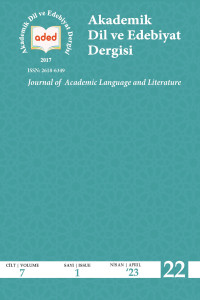Abstract
Bu çalışmada Refik Halit Karay’ın hikâyeleri Rus eleştirmen Mihail Bahtin’in geliş,tirdiği kuramsal yaklaşımlardan kronotop kavramıyla değerlendirilmiştir. Bir anlatı formu olarak romanda, mekân ve zaman tasarımının incelenmesine ilişkin geliştirilen kronotop kavramının hikâye incelenmesi için de elverişli bir yöntem olduğunun gösterilmesi bu araştırmanın gayelerindendir. Zira Karay’ın hikâyelerinde zaman ve mekâna dair önemli bir birikim bulunmaktadır. Maupassant hikâyeciliğini benimseyen Karay’ın, hikâyelerinde göze ilk çarpan özellik bu hikâyelerin mekânlarının çoğunlukla Anadolu coğrafyasından seçilmiş olmasıdır. Türk hikâyesi bu metinlerle Anadolu’ya taşınmış ve metinler sayesinde taşraya bakma fırsatı bulunmuştur. Yazarın hikâyelerinde zaman ve mekâna dair tasarruflar, dönemin sosyal yaşantısının tespit edilmesi ve dolaylı yoldan eleştirel bakış açısının oluşturulması açısından son derece önemlidir. Karay’ın hikâyelerindeki taşra kronotopunun tespitiyle söz konusu taşra kronotopunun işlevleri teknik bir imkân olarak ortaya çıktığı gibi farklı bir okuma yöntemiyle yazarın hikâyelerinde yeni bulgulara ulaşılmıştır. Ayrıca, taşradaki geleneksel zamanın belirli bir mekânla birleşerek ifade ettiği anlam da irdelenmiştir. Bunun yanı sıra, çalışmanın temelini oluşturan kronotop kuramı, Bahtin tarafından çizilen çerçeve içinde edebî metinlerdeki anlam ve işlevlerinin açıklaması için ele alınmıştır.
References
- Bachelard, Gaston (2014). Uzamın Poetikası. ( Alp, Tümertekin Çev. ). İthaki Yayınları.
Abstract
In this study, the stories of Refik Halit Karay were evaluated with the concept of chronotope, one of the theoretical approaches developed by the Russian critic Mikhail Bakhtin. One of the aims of this research is to show that the concept of chronotope, which has been developed for examining the design of space and time in the novel as a narrative form, this is also a suitable method for examining the story. İnasmuch as there is an important accumulation of time and space in Karay's stories. The first striking feature in Karay's stories, who adopted Maupassant's style of storytelling, is that the majority of the places of these stories were chosen from the Anatolian geography. The Turkish story has been brought to Anatolia by these texts and they allowed us to review province. Reflections on time and space in the author's stories are extremely important in terms of determining the social life of the period and indirectly establishing a critical point of view. By identifying the Provincial chronotope in Karay's stories, the functions of this chronotope emerged as a technical possibility, leading to new findings in the author's stories through a different reading method. In addition, the meaning of traditional time in the countryside combined with a certain place has been examined. Moreover, the chronotope theory, which forms the basis of the study, is discussed within the framework drawn by Bahtin for the explanation of its meaning and functions in literary texts.
Keywords
Refik Halit Karay Mikhail Bakhtin The Provincial Chronotope Memle¬ket Hikâyeleri Gurbet Hikâyeleri
References
- Bachelard, Gaston (2014). Uzamın Poetikası. ( Alp, Tümertekin Çev. ). İthaki Yayınları.
Details
| Primary Language | Turkish |
|---|---|
| Subjects | Literary Studies |
| Journal Section | Articles |
| Authors | |
| Publication Date | April 30, 2023 |
| Submission Date | March 13, 2023 |
| Acceptance Date | April 23, 2023 |
| Published in Issue | Year 2023 Volume: 7 Issue: 1 |

